Watch the replay of the Apsara Conference 2022 at this link!
On November 5, at the Apsara Conference 2022 in Hangzhou, Yu Ding (Alibaba researcher and Alibaba Cloud Intelligence General Manager of the Cloud-Native Application Platform) delivered a keynote speech at the cloud-native summit. He proposed that cloud-native had activated new paradigms for application construction and Serverless would lead the next-generation application architecture. Alibaba Cloud will firmly promote the Serverless development of core products to help customers minimize O&M to implement agile innovation better.
After enterprises connect to the cloud, there are still many challenges with application construction in the cloud computing era, such as how to ensure the elasticity of system resources, reduce costs, and increase efficiency, how to achieve agile application development and realize rapid business iteration, and how to ensure the system stability and business continuity. These problems have not been completely solved yet.
Cloud-native has become a very popular technology trend. Cloud-native can help enterprises solve a series of problems (from cloud migration to cloud usage) in application construction from the PaaS level. Three specific paradigms are becoming a reality:
The first paradigm is full containerization. Containers form the standard of O&M. They have become the new interface for enterprises to migrate businesses to the cloud and use the cloud. They have also become the new interface for developers to interact with application systems, which is conducive to building a highly elastic and scalable system, to achieve cost reduction and efficiency increase. Currently, all workloads are containerized, including microservices, online applications, databases, big data, AI, and middleware. We can enjoy the benefits of standardized O&M and flexible architecture with containers. They also bring software that can be deployed and delivered everywhere and standardized O&M management.
The second paradigm is the Internetization of the core technology of the industry. We reconstruct the application system with the technology and the architecture of the Internet, which brings many benefits: distributed scalability and agile business iteration, elastic architecture, and traffic peak handling. For example, preparing a big sale or a New Year's Eve party may face unexpected traffic peaks. Digital systems must be implemented with an Internet architecture to deal with uncertain traffic. In addition, ensuring the system is highly available and reliable and guaranteeing business continuity is also the dividend Internet technologies bring to enterprises.
The third paradigm is Serverless applications. Technically, Serverless technology realizes hierarchical decoupling of technical components, allowing applications to be fully managed and O&M-free, improving system O&M and reducing costs. Since extreme elasticity covers all components, it is very simple to build applications on the cloud.
In the past, to build applications, users needed to buy ECS instances, build open-source software systems, and maintain them. Scaling out and scaling in are required according to the traffic volume. The whole process was complicated. These problems have been simplified by Serverless services. Semi-managed service has turned to fully managed services. Services are API-based, with unlimited capacity and full flexibility, and can be assembled. Productivity has increased significantly. Optimization is also performed during the entire lifecycle of software development. The R&D model is upgraded to allow developers to focus more on business.
The three paradigms above represent a mainstream evolution direction of cloud-native.
According to Gartner, over 75% of global organizations will be running containerized applications in their production environments by 2022, compared with less than 30% in 2020. We have seen that container technology has crossed the gap and has been used in the production system in thousands of industries.
Container Service for Kubernetes (ACK) reduces the threshold of Kubernetes significantly, but managing and maintaining a large-scale and distributed cluster is still full of challenges, such as how to schedule applications to ensure stability while improving resource utilization, how to plan and analyze and optimize applications, and how to locate and fix problems in a cluster in time.
Intelligentization can solve these problems. Intelligentization is an inevitable trend in the development of container platforms. Based on the experience of large-scale containers over the past ten years, Alibaba Cloud made ACK intelligent through data and intelligent algorithms. Alibaba Cloud performs three upgrades:
The first upgrade is intelligent co-located scheduling, a new generation scheduling system, Koordinator. Koordinator helps users improve the overall resource utilization rate.
The second upgrade is intelligent cost governance. ACK provides the FinOps solution to help users make cloud migration costs visible, controllable, and optimizable.
The third upgrade is the intelligent O&M experience. ACK provides the AIOps solution to help users implement data-driven diagnostic decisions and defend and locate faults. Automated diagnosis can cover more than 90% of problems.
These upgrades in capabilities will lower the threshold for the use of container technology and make ACK more inclusive.
Internet middleware products have three features:
Microservices are facing new demands and technical challenges in the cloud-native era, especially in terms of performance, high availability, and security. Today, Alibaba Cloud officially makes cloud-native gateway Higress open-source, which is the industry's first standardized, highly integrated, scalable, and rolling-updated cloud-native gateway.
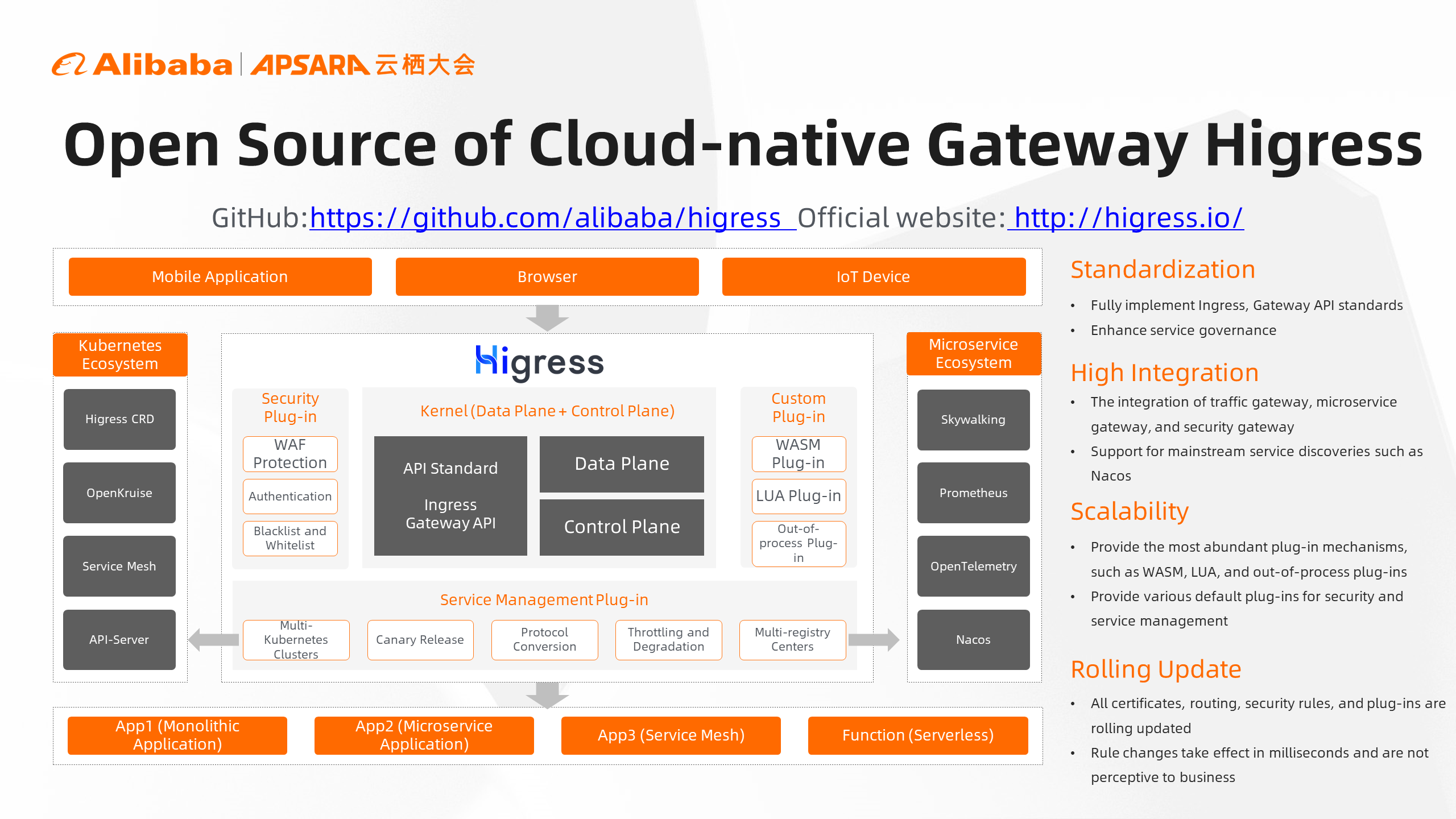
Standardization: With the popularity of Kubernetes, Kubernetes Ingress has gradually become an API fact standard in the cloud-native era. Higress fully supports this standard and has enhanced service governance significantly, including canary release, throttling, prefetch, timeout, and retry, leading the evolution direction of the standard.
High Integration: Higress integrates traffic gateways, microservice gateways, and security gateways for the first time to create a highly integrated gateway. It establishes a high-performance and secure defense line at the ingress. The backend supports multiple runtime routes (such as Kubernetes, Nacos, ECS, and Serverless).
Easy Extension: Higress provides the most abundant plug-in extension mechanism to meet customers' requirements for flexible routing and security customization and supports the most comprehensive language extension mechanisms. In order to reduce the threshold for customers to use Higress, we integrate dozens of plug-ins by default and facilitate developers to contribute common capabilities through the plug-in market, resulting in positive interaction.
Rolling Update: If traditional NGINX update rules need to be reloaded, link jitters occur, resulting in traffic loss and intolerance of real-time communication, video, and IoT. Therefore, Higress adopts the rolling update mechanism for certificates, routing, security rules, and plug-ins, which takes effect in milliseconds, and no business is aware.
In addition to making cloud-native gateways open-source, Alibaba Cloud upgrades Microservices Engine (MSE) 3.0, which includes three core capabilities:
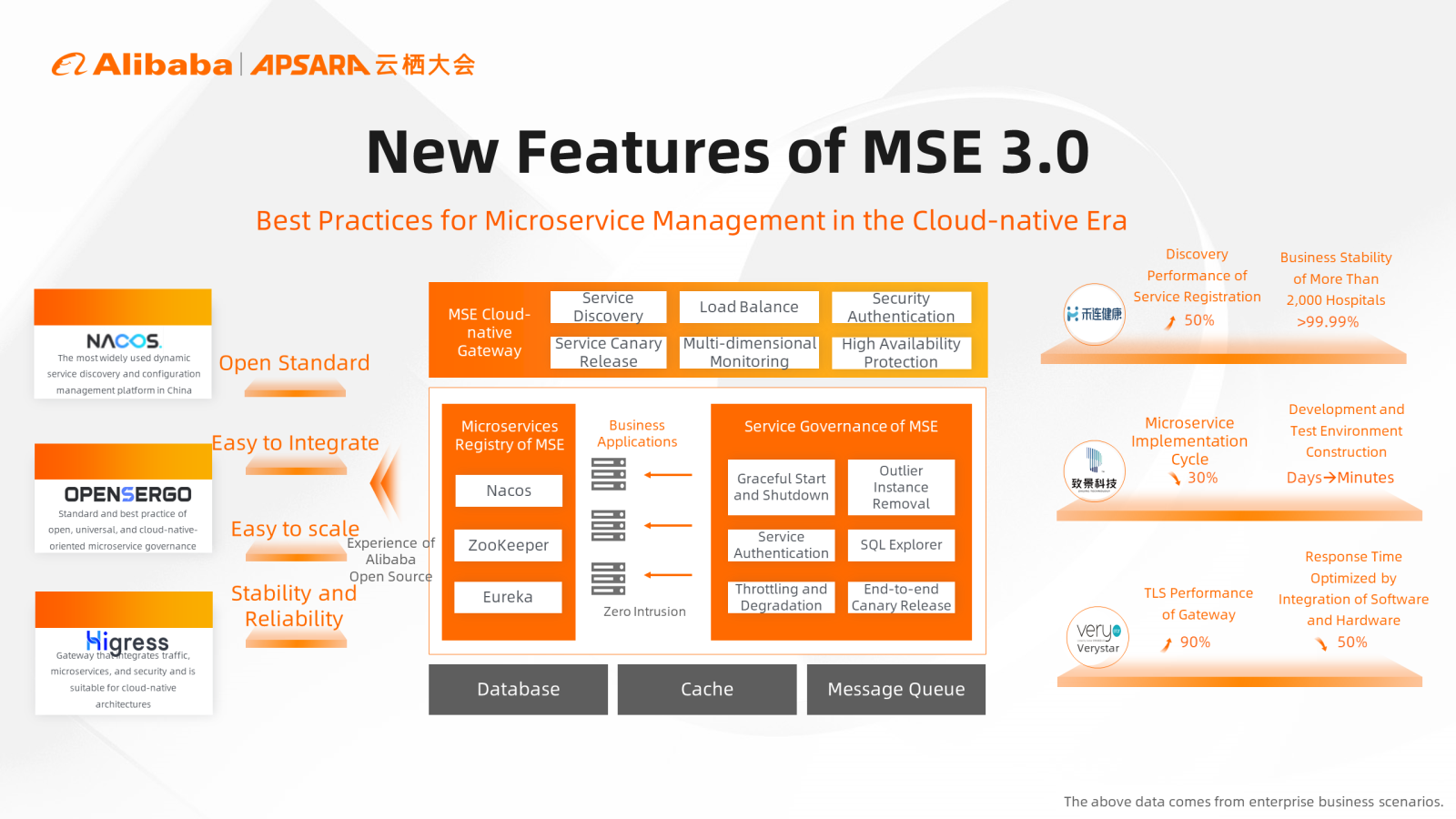
The first capability is microservices registry, which improves performance by 40% compared with mainstream open-source solutions (such as Nacos) and provides more than 70 monitoring indicators and health detection to help customers realize abnormal service autonomy.
The second capability is microservice governance, which has accumulated the practical experience of Alibaba for over ten years. The microservice governance feature helps customers shorten the landing cycle of microservice governance by 30%, improves the efficiency of development and testing by 50%, and eliminates 80% of online risks.
The third capability is the cloud-native gateway. Alibaba Cloud has integrated the traffic gateway, microservice gateway, and security gateway. The architecture has also been upgraded, and instance-level protection is upgraded to route-level protection. The overall performance is improved by 90% compared with traditional gateways.
System architectures are becoming increasingly complex in the cloud-native era. Improving observability has become the only means to reduce complexity. Today, observability has become the standard for measuring the IT level of enterprises. Cost governance, business continuity, and business growth all require observability technologies. Therefore, Alibaba Cloud launched the cloud-native observability solution ACOS to help enterprises achieve cost management, risk governance, and intelligent O&M, and ensure efficient and stable operation of digital businesses from application monitoring to tracing analysis.
Three components of ACOS were also upgraded during the Apsara Conference 2022.
Finally, a multi-dimensional observation perspective is opened for enterprise cloud applications. ARMS is fully integrated with the OpenTelemetry and Prometheus ecosystem in terms of data analysis. OpenTelemetry is used to supplement business and customize component tracking, which improves the observation dimension and is not limited to manufacturers. TraceExplorer is also used to implement a multi-source trace unified query.
Message Queue has always been the core component of the enterprise Internet architecture. Alibaba built RocketMQ in 2012, a popular messaging middleware based on e-commerce scenarios. It also contributed to the Apache community. After being polished for more than ten years, RocketMQ has achieved a lot. The Apache RocketMQ community has more than 700 contributors worldwide. More than 75% of the leading enterprises choose to use RocketMQ, while more than 80% of the mainstream cloud vendors provide RocketMQ commercial hosting services. As the initiator and core contributor of RocketMQ, Alibaba Cloud has served more than 20 industries and more than 100,000 enterprise customers from industries (such as the Internet, retail, and automobile) for over ten years. Alibaba Cloud has been carrying tens of millions of TPS and trillion-level message peaks.
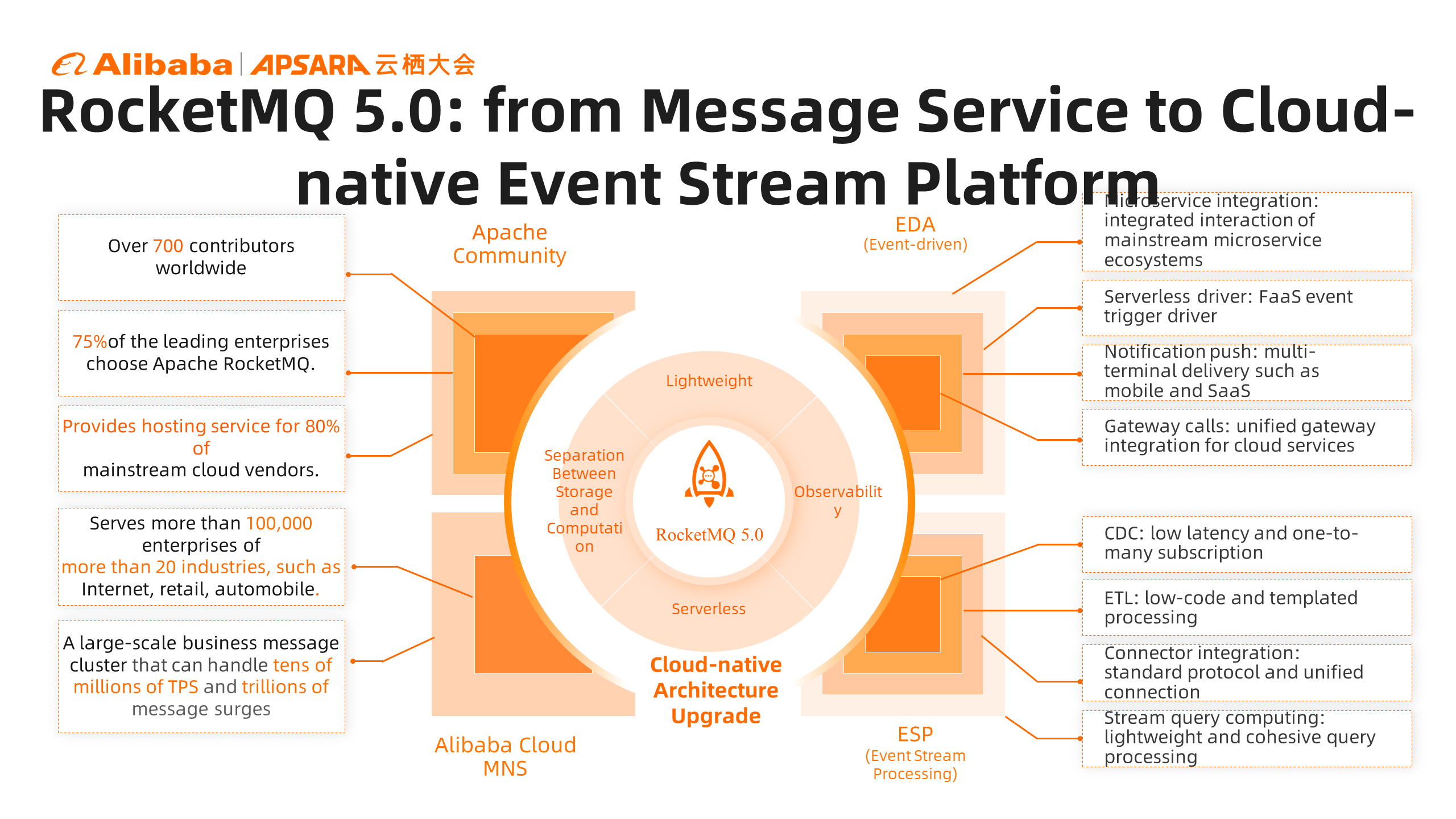
Alibaba Cloud RocketMQ 5.0 has been officially commercialized. It has been fully expanded from the kernel to the ecosystem and upgraded to a cloud-native event stream platform. It has deepened the two core scenarios of event-driven and event stream processing. In the future, enterprise developers can easily drive microservices and Serverless applications based on the RocketMQ event stream platform. They can also reconstruct current stream processing tasks based on RocketMQ to efficiently meet the stream processing requirements (such as CDC and ETL in a lightweight and low-code form).
The capabilities of the cloud are also constantly upgrading because of the deepening of cloud use by enterprises. In the past, enterprises used the cloud to buy resources, instances, and specifications and build applications. We have been saying, "Cloud computing is an infrastructure like water, electricity, and coal," but this has not been fully realized. Alibaba Cloud has been promoting the upgrading of product forms and R&D methods, hoping to transform from providing resources to providing services. This service has plug-and-play capabilities. Enterprises do not need management and maintenance, can realize auto scaling, and are O&M-free. The platform is fully managed and billed based on usage, truly becoming service-based and modular, which is also the direction of cloud product upgrade and evolution. Some have said the singularity of Serverless technology has arrived. The so-called singularity is a turning point from stable development to rapid development, indicating that Serverless technology will be widely used in industries. Currently, Alibaba Cloud has more than 20 Serverless products and will promote the full Serverless trend of core products. Serverless is the best way to implement cloud capabilities and the best paradigm for cloud computing infrastructure to land in thousands of industries.
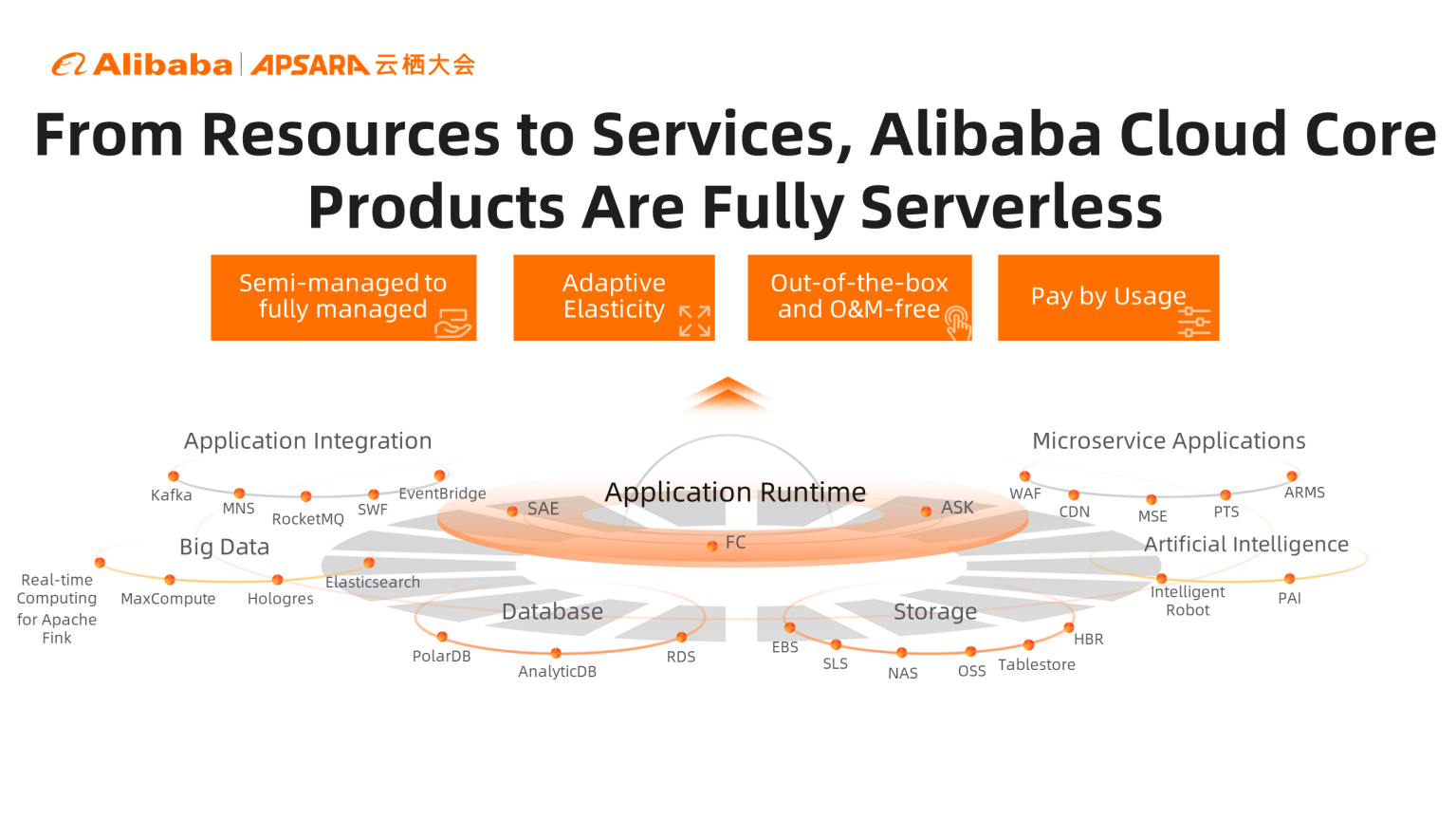
Function Compute (FC), launched in 2017, is a FaaS product. This is an event-driven, fully-managed computing service. Users only need to write code and upload it. Function Compute automatically prepares computing resources, runs code in a flexible and reliable manner, and provides complete observability, which simplifies the development and O&M process significantly. Serverless App Engine (SAE), launched in 2018, is the industry's first application-oriented Serverless PaaS platform. It shields the complexity of underlying IaaS and Kubernetes and provides an application hosting solution with zero code transformation, less cost, and higher efficiency. It helps users make single Web applications, micro-applications, and scheduled tasks serverless. The industry-leading Serverless Kubernetes (ASK) was also launched in 2018. Based on Elastic Container Instance (ECI), it can expand 2,000 pods in one minute, lowering the threshold for Kubernetes usage and allowing users to focus more on applications rather than managing the underlying infrastructure. In 2020, Alibaba Cloud made Serverless Devs open source, which became the first platform in the industry to support cloud-native lifecycle management of mainstream Serverless services and frameworks. In September 2022, the project officially entered CNCF Sandbox and became the first Serverless tool project selected in the industry.
In addition to the changes in product form, Serverless has changed the software development paradigm. As Alibaba Cloud provides more comprehensive Serverless products, many multi-cloud products have become modular, API-based, and service-based. They can be assembled and used to build applications by dragging and dropping. Therefore, under the Serverless architecture, the R&D method is upgraded to R&D by assembling Serverless products. This R&D method can achieve process orchestration, event-driven, and even visualization. This completely subverts the original software R&D method, significantly improves R&D efficiency, and flexibly responds to business challenges. According to the research and statistics of authoritative institutions, compared with the traditional model, assembled R&D can improve efficiency by more than 50%.
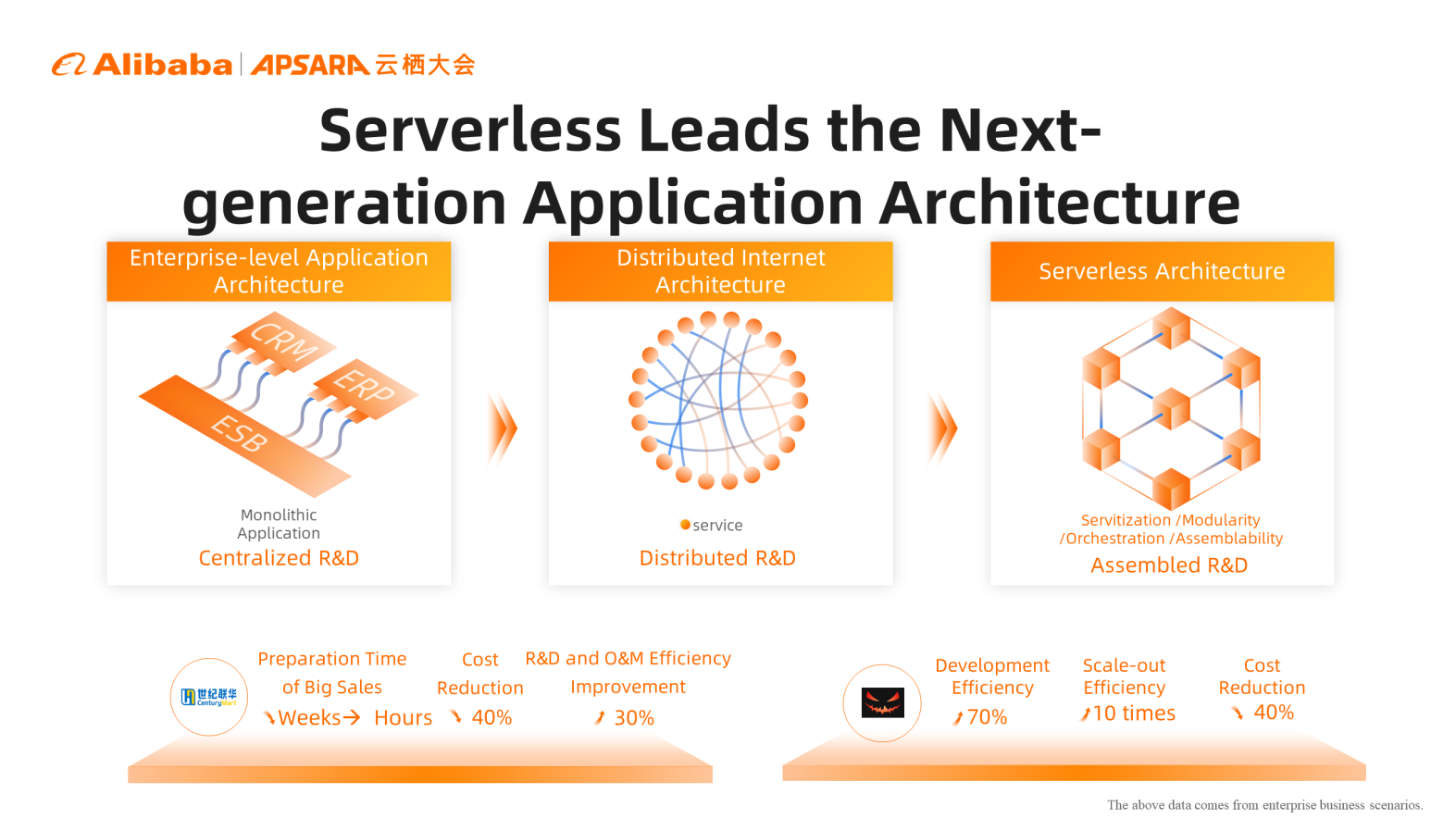
Let's take Pumpkin Film as an example. Due to the release of a hit movie, the number of users on Pumpkin Film's platform increased by one million in one hour. The traffic surge caused the website to be interrupted for a time. Temporary cloud expansion could not meet the huge traffic in time. The traditional architecture did not change the efficiency on the cloud, so Pumpkin Film switched to Serverless architecture. It took three days to complete the launch of core applications, and switching more than 30 core applications to Serverless architecture on the seventh day. Eventually, the expansion efficiency was increased by ten, the cost was reduced by more than 40%, and the R&D efficiency was improved by 70%. This is the value brought by Serverless. Serverless allows developers to focus on the business itself and enterprises to do less but gain more.
In the future, Alibaba Cloud will continue to make breakthroughs in the cloud-native field to promote the rapid development of the Serverless field and industries.
When RocketMQ Meets Elastic Stack | RocketMQ Makes Real-Time Log Analysis Easier

510 posts | 50 followers
FollowAlibaba Cloud Community - December 9, 2022
Alibaba Cloud Native Community - November 22, 2022
Alibaba Cloud New Products - December 4, 2020
Alibaba Clouder - May 18, 2021
Clouders - July 22, 2022
Alibaba Cloud Native Community - November 23, 2022

510 posts | 50 followers
Follow Bastionhost
Bastionhost
A unified, efficient, and secure platform that provides cloud-based O&M, access control, and operation audit.
Learn More Managed Service for Grafana
Managed Service for Grafana
Managed Service for Grafana displays a large amount of data in real time to provide an overview of business and O&M monitoring.
Learn More Function Compute
Function Compute
Alibaba Cloud Function Compute is a fully-managed event-driven compute service. It allows you to focus on writing and uploading code without the need to manage infrastructure such as servers.
Learn More Elastic High Performance Computing Solution
Elastic High Performance Computing Solution
High Performance Computing (HPC) and AI technology helps scientific research institutions to perform viral gene sequencing, conduct new drug research and development, and shorten the research and development cycle.
Learn MoreMore Posts by Alibaba Cloud Native Community
Start building with 50+ products and up to 12 months usage for Elastic Compute Service
Get Started for Free Get Started for Free